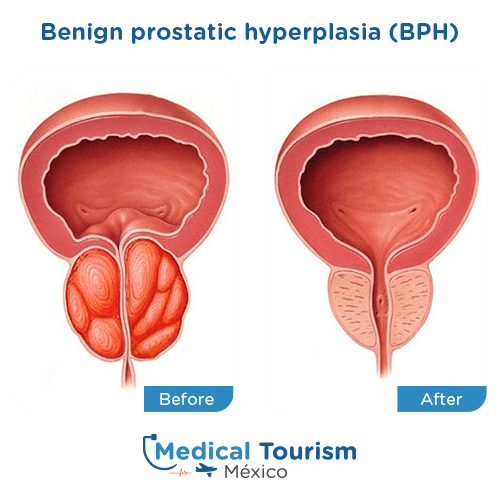The most reliable doctors in Mexico
Benign prostatic hyperplasia - Prostate gland enlargement information and locations in Mexico
Benign prostatic hyperplasia or also known as prostate gland enlargement is a condition in which
the prostate gland increases its size by circumstances not related to cancer. BPH is most common
in men between 51 and 60 years.
The prostate is located near the urethra, as this enlarges it presses against the urethra
causing trouble starting to urinate, the inability to empty the bladder, or urinary
incontinence. Treatments range from prescription drugs to surgery.
Most common procedures and surgeries for benign prostatic hyperplasia
Prostatic urethral lift - PUL
The PUL is a minimally invasive procedure that can be done with either local or general
anesthesia. Using a needle, the urologist places small implants in the prostate to lift
and compress the enlarged prostate so it will no longer block the urethra.
Transurethral incision of the prostate - TUIP
The TUIP is suggested to patients with a small prostate but with major blockage of the
urethra. This procedure consists of widening the urethra using a laser beam or an
electrical current to make small cuts in the prostate gland reducing the pressure and
making urination easier.
Transurethral resection of the prostate - TURP
The TURP is a very common surgery for benign prostatic hyperplasia, the surgeon inserts
a resectoscope, a thin tube-like instrument with light and irrigation, on the tip of the
penis through the urethra to access the prostate. Then the urologist cuts away the
excess tissue that‘s blocking the urethra, then seals any blood vessels. The removed
tissue is flushed by the bladder after the procedure. The patients require to use a
catheter for one to two days; the TURP offers a long-term solution for BPH that requires
local anesthesia and one to two days in the hospital.
Holmium laser enucleation of prostate - HoLEP
HoLEP is used to treat the blockage of urine flow caused by BPH, the procedure consists
of placing a resectoscope to the urethra, then a laser is inserted to cut and remove the
excess prostate tissue and restore the flow of urine. The removed tissue is left in the
bladder to allow the urologist to use a morcellator to suction out the removed tissue.
Water vapor thermal therapy
This treatment uses steam to destroy prostate cells that are squeezing the urethra. The
urologist uses a small needle that releases a precise dose of steam into the enlarged
prostate to cause cell death. Then, the body‘s natural healing response breaks down and
removes the dead tissue causing the prostate to shrink.
Transurethral microwave therapy - TUMT
The TUMT requires local anesthesia and is usually done in the urologist office. This
therapy uses microwave energy to destroy excess prostate tissue. Using a device called
“antenna”, the urologist sends microwaves to heat selected portions of the prostate. The
produced heat destroys excess prostate tissue; a cooling system protects the urinary
tract from heat damage during the procedure.
Benefits
Fast recovery
Can improve urinary flow
Results can be long lasting
Can improve urinary flow
Results can be long lasting
BPH
Procedure:
30 min. - 3 hrs.
Hospital stay: 1 - 1:50 hrs.
Cleared to fly: 2 - 3 days
Hospital stay: 1 - 1:50 hrs.
Cleared to fly: 2 - 3 days
After surgery
Out of town patients do not require follow-ups with the urologist after the procedure. Patients are clear for flying
after 2 - 3 days from a BPH procedure.
Note: Follow-ups can be arranged as face-to-face or virtually. If needed, you can go to your primary care physician to remove sutures or get medication adjustments.
As an Amazon Associate, we earn from qualifying purchases.
Take a look at one of our medical tourism essentials for urology surgery.
Take a look at one of our medical tourism essentials for urology surgery.
Before and after images
View additional images for this procedure.

View more


Locations
Select the city of your choice to seethe doctors profile.
Cancún, Q. Roo.
Dr. Rodrigo González
View more

Benign prostatic hyperplasia - Prostate gland enlargement frequent questions
Get answers to our most frequently asked questions and what to expect after the surgery.
Does BPH cause or lead to cancer?
No, BPH is benign. But in some cases, BPH and cancer can occur at the same time.
Which surgery or treatment will I need?
Depending on the physical condition and symptoms of the patient. The specialist will evaluate which approach is better to help alleviate the pain.
Can erectile dysfunction occur after surgery or treatment?
The risk for erectile dysfunction is small in laser surgery compared with traditional surgery. Although, as with any other procedure there are risks, please speak with your specialist for more information.
Recent news
Disclaimer: This information does not reflect the medical advice from our clinics. All cases are different and this treatment may not suit you. Always refer to a medical professional with the certification and experience. All of our physicians are fully qualified to perform these procedures. For more information and diagnosis contact one of our top specialized clinics.
In all medical procedures, there are chances of complications, the specialist will provide you detailed information about the risks of the procedure, talk to the specialist directly.
In all medical procedures, there are chances of complications, the specialist will provide you detailed information about the risks of the procedure, talk to the specialist directly.





